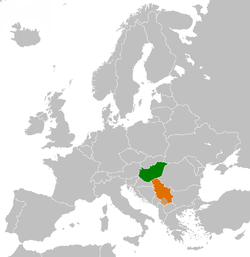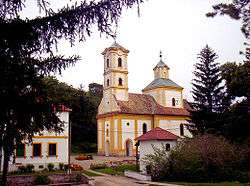Hungary–Serbia relations
 | |
Hungary |
Serbia |
|---|---|
History of diplomatic relations of Hungary and Serbia dates back to 21 November 1882, when they were established between Serbia and Austria-Hungary. Today, Hungary has an embassy in Belgrade and a general consulate in Subotica, while Serbia has an embassy in Budapest and an honorary consulate in Szeged.
The two countries share 151 km of common border. There are around 254,000 people of Hungarian descent according to the latest census living in Serbia and around 7,000 people of traditional Serbian descent living in Hungary (not counting migrants from Serbia to Hungary since the 1990s).
Even Hungary's relationship with Serbia is considered as warmer than with Romania, however, some Hungarian nationalist groups have refused to recognize Serbian control over Vojvodina, which is called "Delvidék" in Hungarian, due to its conflict at the past, notably the Treaty of Trianon.
Country comparison
| Name | Hungary | Serbia | ||
|---|---|---|---|---|
| Official name | Hungary (Magyarország) | Republic of Serbia (Република Србија) | ||
| Coat of Arms |  |
 | ||
| Flag |  |
 | ||
| Population | 9,830,485 | 7,076,372 | ||
| Area | 93,028 km2 (35,919 sq mi) | 88,361 km2 (34,116 sq mi) [Note 1] | ||
| Population Density | 105.9/km2 (274.3/sq mi) | 92.8/km2 (240.4/sq mi) (excluding Kosovo) | ||
| Government | Unitary parliamentary constitutional republic | Unitary parliamentary constitutional republic | ||
| Capital | Budapest – 1,759,407 (2,524,697 Metro) | Belgrade – 1,166,763 (1,344,844 Urban) | ||
| Largest City | ||||
| Official language | Hungarian (de facto and de jure) | Serbian provincial languages: Hungarian, Slovak, Romanian, Croatian, Rusyn | ||
| Main religions | 38.9% Catholicism (Roman, Greek), 13.8% Protestantism (Reformed, Evangelical), 0.2% Orthodox, 0.1% Jewish, 1.7% other, 16.7% Non-religious, 1.5% Atheism, 27.2% undeclared | 84.6% Orthodox, 5% Roman Catholicism, 3.1% Islam, 1% Protestantism, 5.3% other | ||
| Ethnic groups | 83.7% Hungarian, 3.1% Roma, 1.3% German, 14.7% not declared | 83.3% Serb, 3.5% Hungarian, 2.1% Roma, 2% Bosniak, 9% other | ||
| GDP (nominal) | $132.683 billion, $13,487 per capita | $39.541 billion, $5,544 per capita (excluding Kosovo) | ||
| External debt (nominal) | $202.000 billion (2012 Q4) – 115 % of GDP | $32.600 billion (2012 Q4) – 80 % of GDP | ||
| GDP (PPP) | $265.037 billion, $26,941 per capita | $106.537 billion, $14,938 per capita (excluding Kosovo) | ||
| Currency | Hungarian forint (Ft) – HUF | Serbian dinar (дин) – RSD | ||
| Human Development Index | 0.828 (very high) | 0.771 (high) | ||
| Expatriate populations | 10,038 Serbian citizens lived in Hungary in 2011 (census)[2] | 253,899 Hungarian citizens lived in Serbia in 2011 (census) |
History
Hungary signed a non-aggression and "Treaty of Eternal Friendship" with Yugoslavia on 12 December 1940 however it participated in Axis invasion on Yugoslavia which prompted then Prime Minister of Hungary Pál Teleki to commit suicide.[3]
In 2013 a historical reconciliation was marked.[4] President of Hungary, János Áder gave speech in front of the National Assembly where he issued an official apology for the Hungarian role in the World War II persecution of Serbs such as Novi Sad raid.[5] In turn, in 2014 Serbian National Assembly symbolically voided Yugoslav laws on collective guilt of Hungarian people for crimes committed during the World War II.[6] Hungary has praised Serbia's treatment of minorities, commending the cultural autonomy and use of minority languages in Serbia.[7]
Serbian heritage in Hungary

The presence of Serbs in the territory of present-day Hungary date from the Middle Ages. The mother of the Hungarian king Géza II (1141-1162) was Helena of Raška, a daughter of the great župan of Raška, Uroš I. During the rule of Géza II, her brother Beloš Vukanović was a palatine of the Kingdom of Hungary. Since the 14th century, escaping from the Ottoman threat, a large number of Serbs migrated to the Kingdom of Hungary.
The most complex example of Serb architectural heritage in Hungary is the old town of Szentendre (Serbian: Sentandreja), next to the Danube, with 7 Orthodox Churches (two of which have been sold), brightly coloured merchant houses and the Museum of Serb Orthodox Heritage. In Budapest, the Serb Orthodox Cathedral in the Tabán district was damaged in WWII and later demolished. There is an old Serb Orthodox Church in Serb Street, Pest and the famous Serb college, Thökölyanum (Serbian: Tekelijanum).
There are Serbian churches in Vác (Vac), Székesfehérvár (Stoni Beograd) with a Serbian open-air village museum, Szeged (Segedin), Baja (Baja) with two churches, Mohács (Mohač), Siklós (Šikloš), Eger (Jegra), Győr (Đur), Esztergom (Ostrogon), Hódmezővásárhely (Vašarhelj).
There are also village churches in Pomáz (Pomaz), Csobánka (Čobanac), Izbég, Ráckeve (Srpski Kovin, rare example of Serb Gothic architecture from the 15th century), Lórév (Lovra), Szigetcsép (Čip), Budakalász (Kalaz), Magyarcsanád (Čanad), Battonya (Batanja), Deszk (Deska), Szőreg (Sirig), Dunapentele (Pantelija, now Dunaújváros), Százhalombatta (Bata), Dunaföldvár (Feldvar), Alsónána (Donja Nana), Bátaszék (Batsek, demolished in the 1960s), Medina (Medina), Illocska (Iločac), Magyarbóly (Madžarboja), Dunaszekcső (Sečuj), Villány (Viljan), Sárok (Šarok), Majs (Majš), Lippó (Lipova), Beremend (Breme), Erdősmecske (Racmečka), Somberek (Šumberak), Véménd (Vemend, demolished), Nagybudmér (Veliki Budmir, demolished in 2001), Hercegszántó (Santovo), Újszentiván (Novi Sentivan).
There are two Serbian Orthodox Monasteries, one in Ráckeve (Srpski Kovin) and one in Grábóc (Grabovac).
Hungarian heritage in Serbia
Parts of the Vojvodina region were included into the medieval Kingdom of Hungary in the 10th century, and Hungarians then began to settle in the region, which before that time was mostly populated by Slavs. During Hungarian administration, Hungarians formed the largest part of population in northern parts of the region. Count Imre Csáky settled Hungarians in his possessions in Bačka in 1712. In 1745, Hungarian colonists settled in Senta, in 1750 in Topola, in 1752 in Doroslovo, in 1772 in Bogojevo, in 1760 in Stara Kanjiža, in 1764 in Iđoš, in 1767 in Petrovo Selo, in 1776 in Martonoš, in 1786 in Pačir and Ostojićevo, in 1787 in Piroš, and in 1789 in Feketić. Between 1782 and 1786, Hungarians settled in Crvenka and Stara Moravica, and in 1794 in Kula. Between 1751 and 1753, Hungarians settled in Mol and Ada (Those originated mostly from Szeged and Jászság). In 1764–1767, Hungarians settled in Subotica, Bajmok and Čantavir, and in 1770 again in Kanjiža, Mol, Ada and Petrovo Selo, as well as in Feldvarac, Sentomaš and Turija. In Banat, the settling of Hungarians started later. In 1784 Hungarians settled in Padej and Nakovo, in 1776 in Torda, in 1786 in Donji Itebej, in 1796 in Beodra and Čoka, in 1782 in Monoštor, in 1798 in Mađarska Crnja, in 1773 in Krstur and Majdan, in 1774 in Debeljača, in 1755–1760 in Bečkerek, and in 1766 in Vršac. In the 19th century, the Hungarian colonization increased. From the beginning of the century, the Hungarian individuals and small groups of settlers from Alföld constantly immigrating to Bačka. In the first half of the 19th century larger and smaller groups of the colonists settled in Mol (in 1805), as well as in Feldvarac, Temerin and Novi Sad (in 1806). In 1884, Hungarian colonists settled in Šajkaška and in Mali Stapar near Sombor. In 1889, Hungarians were settled in Svilojevo near Apatin and in 1892 in Gomboš, while another group settled in Gomboš in 1898. Many Hungarian settlers from Gomboš moved to Bačka Palanka. After the abolishment of the Military Frontier, Hungarian colonists were settled in Potisje, Čurug, Žabalj, Šajkaški Sveti Ivan, Titel and Mošorin. In 1883 around 1,000 Székely Hungarians settled in Kula, Stara Kanjiža, Stari Bečej and Titel. In 1800, smaller groups of Hungarian colonists from Dunántúl settled in Čoka, while in the same time colonists from Csanád and Csongrád counties settled in area around Itebej and Crnja, where they at first lived in scattered small settlements, and later they formed one single settlement - Mađarska Crnja. In 1824, one group of colonists from Čestereg also settled in Mađarska Crnja. In 1829 Hungarians settled in Mokrin, and in 1880 an even larger number of Hungarians settled in this municipality. In 1804, Hungarian colonists from Csongrád county settled in Firiđhaza (which was then joined with Turska Kanjiža), as well as in Sajan and Torda. Even a larger group of Hungarians from Csongrád settled in 1804 in Debeljača. In 1817–1818 Hungarians settled in Veliki Bikač, and in 1820–1840 smaller groups of Hungarians settled in Vranjevo. In 1826, colonists from Jászság and Kunság settled in Arač near Beodra. In 1830, Hungarians from Alföld settled in Veliki Lec, in 1831 in Ostojićevo, in 1832 in Malenčino Selo near Veliki Gaj, in 1839 and 1870 in Padej, in 1840 in Jermenovci and Mađarski Sentmihalj, in 1840–1841 in Dušanovac, in 1841 in Hetin, in 1859 in Sanad, in 1869 in Đurđevo (later moved to Skorenovac), and in 1890 in Gornja Mužlja. In 1883-1886, Székely Hungarians from Bukovina were settled in Vojlovica, Skorenovac, Ivanovo and Đurđevo. Total number of Székely colonists was 3,520.
The first Hungarian settlers in Syrmia moved there during the 1860s from neighbouring counties, especially from Bačka.
Hungarians of Roman Catholic faith originated mostly from Dunántúl, while Hungarians of Protestant faith originated mostly from Alföld.
Gallery
 Memorial plaque at the Embassy of Serbia, Budapest in memory of Imre Nagy who found a sanctuary there during the Hungarian Revolution of 1956
Memorial plaque at the Embassy of Serbia, Budapest in memory of Imre Nagy who found a sanctuary there during the Hungarian Revolution of 1956
Economy
Hungary → Serbia
A mutual trade plays an important role in the economy of both countries. In 2015, Serbia was the 18th most important trading partner of Hungary. Serbia was among one of, the most important countries for Hungary (export: the 18th place, import: the 26th place). [8]
| Million (€) | 2012 | 2013 | 2014 | 2015 |
|---|---|---|---|---|
| Export | 1,244.019 | 1,190.983 |
1,300.511 |
1,264.637 |
| Import | 356.102 | 469,352 |
433.110 |
538.397 |
| Balance | 887.917 | 721.631 | 867.401 | 726.240 |
Most important Hungarian investors in Serbia: OTP Bank, MOL, Masterplast
Resident diplomatic missions
- Hungary has an embassy in Belgrade (Belgrád)[9] and a general consulate in Subotica (Szabadka).[10]
- Serbia has an embassy in Budapest (Будимпешта)[11] and an honorary consulate in Szeged (Сегедин).
Ambassador
Ambassador of Hungary, in Serbia
- dr. Attila Pintér, 18 November 2014-
Ambassador of Serbia, in Hungary
- Rade Drobac, 9 May 2013-
See also
References and notes
Notes
- ↑ The figure shown includes the area of Kosovo and Metohija, which is de facto independent from Serbia as the Republic of Kosovo (10,887 km2 or 4,203 sq mi). The area of Serbia without Kosovo is 77,474 km2 (29,913 sq mi).[1]
References
- ↑
- ↑ "Hungarian census 2011 - final data and methodology" (PDF). ksh.hu. Retrieved 2015-05-18.
- ↑ Horthy, Miklós; Andrew L. Simon (Original Text Copyright 1957,). "The Annotated Memoirs of Admiral Milklós Horthy, Regent of Hungary". Ilona Bowden. Retrieved July 6, 2012. Check date values in:
|date=(help) - ↑ Historical reconciliation between Hungary and Serbia
- ↑ Hungary's president apologizes to Serbia for WW2 crimes
- ↑ Big Step Forward In Hungarian-Serbian Reconciliation
- ↑ Solyom commends minority rights in Serbia
- ↑ MKIK Gazdaság- és Vállalkozáskutató Intézet
- ↑ Embassy of Hungary in Belgrade
- ↑ General Consulate of Hungary in Subotica
- ↑ Embassy of Serbia in Budapest
External links
- Hungarian embassy in Belgrade
- Hungarian general consulate in Subotica(in Hungarian and Serbian only)
- Serbian Ministry of Foreign Affairs about relations with Hungary
- Serbian embassy in Budapest (in Hungarian and Serbian only)


